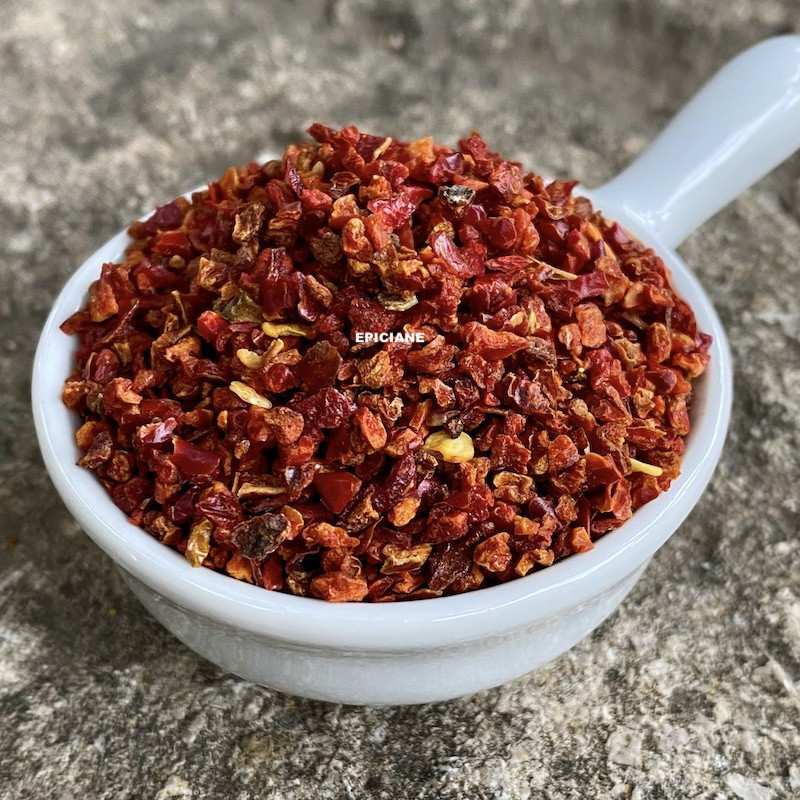
Reference: kenya



It’s an excellent substitute for fresh bell pepper and much easier to digest!
Incredibly easy to use, it requires no peeling, is always available, and only takes a few minutes to rehydrate!
 Delivery
Delivery
Mondial Relay
 Returns
Returns
See conditions
 Payments
Payments
100% secure
Produit livré en sachet refermable
Culinary Uses:
These organic red bell peppers, cut into small pieces, are ideal for preparing any dish in a hurry! With no peeling required, always available regardless of the season, and full of rich flavor and aroma, they rehydrate in just a few minutes. Perfect for salads, omelets, meats, and other "express" dishes—ideal for the busy cook! They’re essential in tabbouleh (you'll find them in our tabbouleh mix), Niçoise salad, and rice salad. They also enhance the flavor of a simple tomato salad.
For most cooked dishes, add them directly at the start of cooking; they’ll rehydrate in just minutes. For uncooked dishes (like salads) or briefly cooked dishes (like omelets), soak them in a bit of warm water for a few minutes (or in beaten eggs for omelets) to ensure they’re tender.
In addition, dehydrated peppers, like dehydrated garlic and onions, are much easier to digest than fresh ones, which can sometimes feel heavy on the stomach!
Who Am I?
Origin: China
Scientific Name: Capsicum annuum
Common Names: Sweet pepper, American pepper
Bell peppers are commonly used in Mediterranean cuisine.
They’re among the vegetables richest in vitamin C and also contain high levels of vitamins A, B, and E, as well as phosphorus, calcium, magnesium, iron, copper, and carotenoids. As peppers ripen, their vitamin C content increases, making colorful peppers more nutrient-dense than green ones.
Though often considered a vegetable, the bell pepper is actually a fruit, belonging to the Solanaceae family. It’s grown as an annual plant in temperate climates since it’s very frost-sensitive, but in its tropical Central American origin, the bell pepper can live for several years. The plant has an upright, almost shrub-like growth habit, reaching about 50 cm in height, with large, pointed green leaves and numerous small white flowers.
Peppers and chilies are distinguished by their size: the larger they are, the milder they are, while smaller ones are spicier. “Pepper” typically refers to large, mild fruits, while “chili” refers to smaller, hotter ones.
At the start of their growth, all peppers are green, only changing color when ripe to become yellow, red, orange, etc. Only certain Spanish varieties remain green even when fully ripe.
Fresh peppers should ideally only be found from June to October, when they’re also the cheapest. The rest of the year, they come from greenhouses or from far-flung regions of the world.
A Bit of History:
The term “pepper” (poivron) comes from the word “pepper.” When Christopher Columbus’s physician first saw the small red berries of a chili plant, he mistook them for a type of red pepper, and the name stuck.
The bell pepper was introduced to Europe in the 16th century, along with its chili relatives, thanks to Columbus’s expeditions.
In Mexico, pepper seeds over 5,000 years old have been found, and Mexican artifacts suggest their existence at least 7,000 years ago!
Data sheet
 YANN P.
YANN P.
délicieux et super pratique ,au top

 YANN P.
YANN P.
délicieux et super pratique ,au top

Reference: kenya
Reference: EPI2301007
Reference: 20211003
Reference: EPI2301013
Reference: 00033663-0001
Reference: pilipili
Reference: paprikafumé
Reference: paprika
Reference: 10814501
Reference: 10707402
Reference: 20813701
Reference: 12M6951701


It’s an excellent substitute for fresh bell pepper and much easier to digest!
Incredibly easy to use, it requires no peeling, is always available, and only takes a few minutes to rehydrate!